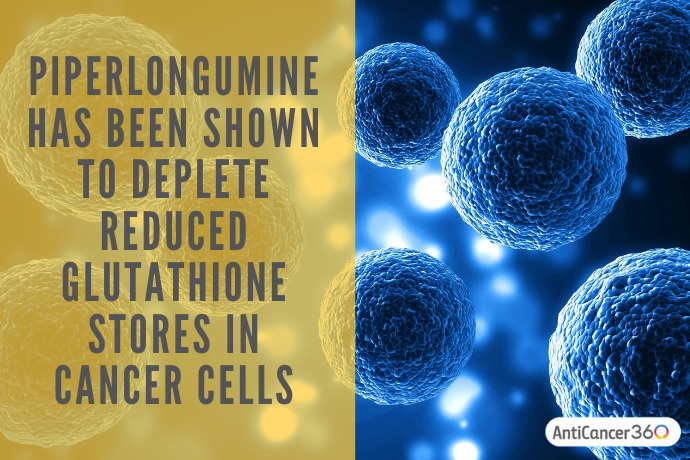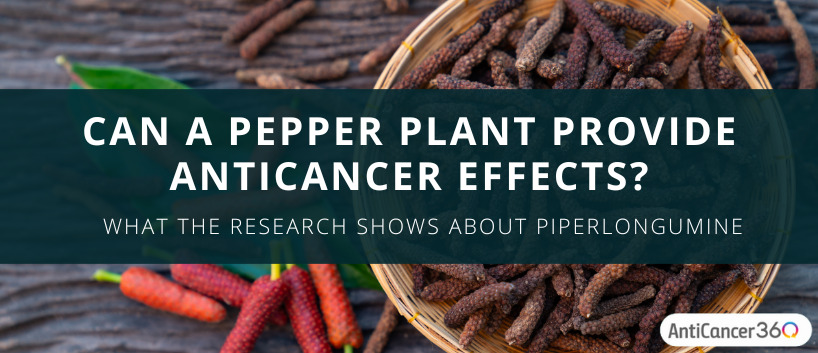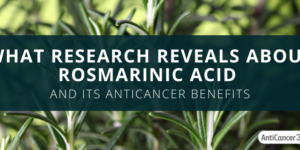A cancer diagnosis can be a scary thing to hear. Deciphering the news of the diagnosis, treatment plans, and the mental burden, people diagnosed with cancer often look to additional methods to help fight it. Other methods include diet, exercise, and experimenting with dietary supplements on top of their medication regimen.
One supplement that people use is piperlongumine. In this post, we’ll discuss piperlongumine and the encouraging evidence regarding its activity against cancer.
What is piperlongumine?
Piperlongumine is a naturally occurring molecule from the Long pepper plant fruit and roots, growing in India and Southeast Asia [1]. Piperlongumine can be consumed through the diet by ingesting the Long pepper plant fruit or roots, but it is also available as an oral supplement in capsule form.

Anticancer Potential of Piperlongumine
Piperlongumine is selectively toxic to cancer cells by generating reactive oxygen species (ROS) [2]. In preclinical studies, piperlongumine has been shown to halt cancer cells from growing and spreading, increasing cell death [3].
Evidence suggests that piperlongumine can be beneficial for various types of cancers, such as breast, colon, liver, lung, prostate, skin, head and neck, and thyroid [4].
Piperlongumine and Luteolin: Potential Anticancer Benefits
Luteolin is a component of piperlongumine that has shown potential anticancer effects. A 2014 study assessed the benefit of luteolin and demonstrated anticancer activity in lung, head, and neck cancers. The study also showed that luteolin had a significant effect on reducing tumor growth in squamous cell carcinoma of head and neck cells in mice. The effect was stronger when the luteolin concentration was higher and packed within concentrated delivery molecules [5].

Later, a 2020 study assessed piperlongumine concentrated molecules in triple-negative breast cancer cells. The findings of this study showed that piperlongumine inhibited cancer growth in triple-negative breast cancer cells and further found that the piperlongumine did not require high concentrations to see anticancer effects. Moreover, free piperlongumine showed comparable benefits [6].
How does Piperlongumine work against cancer cells?
Piperlongumine takes action in a condition known as tumor hypoxia. Tumor hypoxia occurs when tumor cells have less oxygen than normal, leading to tumor growth. When this occurs, chemotherapy and radiation do not work as well, thus worsening treatment outcomes [7]. Recent evidence suggests that protecting against reactive oxygen species (ROS), a byproduct of tumor hypoxia that can lead to cell damage, can help overcome the tumor cell’s resistance to chemotherapy and radiation [8]. Piperlongumine can help ROS accumulate specifically in cancer cells, thus inducing their death while protecting healthy cells from accumulating the harmful molecules [9].

In the sections below, we’ll explain the evidence behind piperlongumine’s anticancer effects via glutathione and the Notch and SREB2 pathways.
Piperlongumine and glutathione
Glutathione is an antioxidant that protects cells from harm. Enzymes involved in glutathione production and processing are frequently overexpressed in cancerous tumors—which helps cancer cells thrive [10]. Thus, an exciting finding that has been demonstrated in several studies is that piperlongumine can actually deplete glutathione stores in cancer cells [11]. Further, piperlongumine has been shown to act as an immunosuppressant by exerting prooxidative effects on immune system cells.

These powerful anticancer effects may even improve the body’s response to cancer treatment [12].
Notch pathway
Notch is a receptor on the surface of cells that plays a role in cell growth, recognition, and cell death. With cancer, Notch is dysregulated and can lead to the growth of cancer cells. Notch dysregulation is thought to be involved in many cancers, such as breast, prostate, head and neck, lung, colon, pancreatic and skin cancers. Further, dysregulation of the Notch pathway is associated with worse outcomes [13].
The Notch pathway is dependent on reactive oxygen species (ROS) [14]. As discussed above, piperlongumine protects your body from harmful outcomes through antioxidant effects. It works by concentrating harmful ROS only in cancer cells leading to their death while protecting against ROS accumulation in healthy cells [5].

Therefore, it’s thought that piperlongumine can help protect and preserve the Notch pathway function by selectively targeting tumor cells and leading to cancer cell death [15].
Piperlongumine, SREBP2, and cholesterol metabolism
Sterol Regulatory Element-Binding Protein 2 (SREBP-2) plays an important role in your body’s metabolism. When your body’s cellular cholesterol levels are low, SREBP2 activates your body to express genes that lead to cholesterol uptake and stimulate the body to produce cholesterol. When your body’s cholesterol levels are high, SREBP-2 signals your body to stop producing cholesterol and works to get rid of excess amounts in the body [16].
Cancer cells significantly hinder the body’s ability to carry out these normal metabolic processes. Cancer can target your cells and the components responsible for normal functioning, including SREBP2. In cancer cells, cholesterol metabolism is abnormal and leads to uncontrolled and rapid cancer cell growth [17].

A 2017 study found that reactive oxygen species can activate SREBP-2, leading to the growth of cancer cells and abnormally high cholesterol levels. Therefore, the administration of piperlongumine suggests it can play a protective factor in helping to regulate and maintain your body’s normal healthy cholesterol metabolism [18].
Frequently Asked Questions about Piperlongumine
What form of piperlongumine is the best? How much piperlongumine should I take?
Piperlongumine can be consumed either through the diet or as a supplement in capsule form. While it isn’t clear which form is best for anticancer effects, most studies administer piperlongumine in capsule form. It is available in several commercial formulations, such as 500-milligram oral capsules that may be taken up to three times daily or as directed by a professional.
Is it safe to consume piperlongumine with medications?
Some drug interactions have been reported with piperlongumine. Interactions have been observed with the following medications [19]:
- Phenytoin: Taking piperlongumine with phenytoin increases the effect and possible side effects of phenytoin [20].
- Propranolol: Taking piperlongumine with propranolol increases the effect and possible side effects of propranolol, such as impacting blood pressure and heart rate [21].
- Theophylline: Taking piperlongumine with theophylline increases the effect and possible side effects of theophylline [22].
- Cyclosporine: Piperlongumine contains a chemical known as piperine, which increases the levels of cyclosporine in the body, thus increasing the possibility of side effects and effects of cyclosporine [23].
This is not a complete list, and other interactions are possible. Before taking any supplement, including piperlongumine, discuss with a healthcare professional to help avoid potentially unsafe drug-herb combinations.
Are there side effects of piperlongumine?
Piperlongumine is generally thought to be safe when observed in toxicology studies. It is readily absorbed through the gastrointestinal tract [24].

While no severe side effects have been observed, there is not enough evidence to say whether it is safe to take piperlongumine while pregnant or breastfeeding [25]. Likewise, piperlongumine may also affect blood clotting and increase the risk of bleeding in those with bleeding disorders.
What are some other health benefits of piperlongumine?
Aside from its anticancer potential, studies suggest other health benefits of piperlongumine. To name a few examples, the compound may play a role in the following:
- Asthma: A 2019 study found that administration of piperlongumine reduced ovalbumin-induced asthma and minimized airway inflammation in mice. More studies are needed to confirm these results in humans, but this data suggests that this effect may also aid in asthma in the human body [26].
- Diabetes: In pre-clinical studies in rats, piperlongumine was found to support healthy blood sugar levels by enhancing insulin secretion, thus lowering blood sugar. This minimized inflammation of organ tissues in the pancreas and liver of the rats as well. In a 30-day study, the rats treated with piperlongumine had much lower blood glucose than untreated rats [27].
- Inflammation: A clinical study in 2020 found that piperlongumine decreased inflammation signs in psoriasis [28]. In an animal study, piperlongumine also reduced oxidative stress in rats, thus reducing inflammation and activating antioxidants [29].
Bottom Line
Overall, you can see that there can be many potential benefits to adding a piperlongumine supplement…and when you’re fighting cancer, you want to take full advantage of every possible anticancer strategy, including a healthy diet and beneficial supplements.
Ultimately, when using an “Aggressive Integrative Approach” to cancer, the goal is to design a plan and lifestyle that fights your cancer from every direction. This approach includes integrating anticancer dietary supplements in a way that complements your oncology treatment plan.
Be sure to consult a member of your healthcare team before starting a piperlongumine supplement. They can also help advise you about dosage and answer any questions about your unique situation and whether piperlongumine is right for you.
If you’d like to know more about the AntiCancer360 approach and see if we can help you, please watch our free online webinar to learn more. Then at the end, you’ll be able to schedule a free call with someone from our team so that we can discuss your case in more detail and answer any questions that you have.
Dr. Patricia Weiser is one of AntiCancer360’s consultant pharmacists, science advisors, and medical writers. Her expertise helps us create safe herbal and supplement combinations and avoid potential drug interactions.
Patricia is a graduate of the University of Pittsburgh and a licensed pharmacist. She has clinical experience in both community and hospital pharmacy. She is passionate about integrative and preventative care and strives to empower her patients to take an active role in their health.







